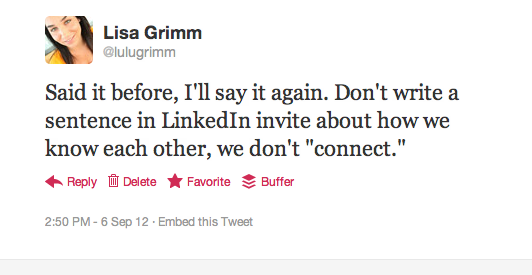Social Media is tough. There are no established “rules of the road” and there are varying degrees of fluency and usability across social networks. Because I’m immersed in social all the time, I sometimes forget how new this still is to the masses and that there is a substantial learning curve for folks when it comes to following, friending and connecting. I have been acutely reminded of this with a recent influx of LinkedIn invites from people I’ve never met with no note or context to why they want to connect. I’ll add that some of these come from people I have met or know in some capacity, but not terribly well. As the careless and contextless LinkedIn invites grow, I thought it would be fun to expand on some of my sporadic tweet rants and offer some insight and tips on best practices for “connection” on LinkedIn.
LinkedIn is about “connection,” not “contacts”
A LinkedIn “connection” is just that, a connection not a contact. There’s a difference in language there. Industrial revolution business practices thrived on “contacts.” Sure, the top echelon of PR, marketing and sales folks knew the value of building relationships and meaningful connections, but most business disciplines thrived on “contacts,” lists, blasts and other one-way, one-sided, talk at you behavioral business tactics. These practices were largely dictated by the mechanical cultures of a rapidly growing, highly commoditized and Corporate America. This is no longer the world we live in. While we still have all of these factors, the digital era offers two-way communication tools like LinkedIn that have the ability to connect us to a global audience in real-time, offering new possibilities, opportunities and applications for us to “connect.” And of course, few know what to do because we’re conditioned to accumulate contacts in mass, not develop quality connections and interactions. Quantity has its place, but quality connections always yield a higher value. Let’s start creating more of them:-)
Care
Treat digital interactions like you would any in-person exchange. Revolutionary and groundbreaking I know, but many of us don’t do this enough – in person or online. It wouldn’t hurt all of us to stop and take a minute in our interactions with other humans — to listen, to relate, to act with intent. If we meet at an event and I start to hand you my business card prior to a proper introduction and conversation, would you find it odd? The answer is yes (I hope) because it is odd. I’ve had it happen numerous times and it disturbs me. It is not appropriate for me to hand you my business card yet. We’ve barely met and established a need to have a future conversation. But again, we’re conditioned to do this. Add another one to the Rolodex or email blast list — or whatever. Digitally, this translates to a quick click of the send button in places like LinkedIn. Let’s stop doing this:-)
Context
LinkedIn is actually built to connect people who know each other based on a professional or friendly context. That’s why you have to designate how you know them prior to sending an invite, however people still have the option to designate someone as a friend or connect with people they don’t know through groups (if you’re both members). That should say enough, but unfortunately people game the system or disregard it entirely. Let’s stop disregarding it:-) Take the one minute (that’s all it takes) to write a quick note setting up how we know each other and why you want to connect. Whether you’ve met this person, worked with this person, are trying to recruit this person or just want to connect with them because you dig their work, take a moment to write a quick sentence or two. Address the person by name. “Hey there. I really enjoy what you post on Twitter and would love to be connected here as well,” or “It was great getting to know you briefly at X event. I enjoyed our conversation about X. I’d love to stay connected here.” Sign your name. No matter what level of connection I have with someone — from acquaintance to having worked with someone for a long period of time — I take the one minute and write a note.
These don’t just apply to LinkedIn, but modern marketing practices as well. We need to redefine why we do things and create more intent with our actions. Based on conversations I’ve had with folks on Twitter and elsewhere about this subject there is much to add. I’d love to hear your thoughts.


 I create purpose-driven experiences that establish meaningful connections between people and brands through the convergence of technology and communication.
I create purpose-driven experiences that establish meaningful connections between people and brands through the convergence of technology and communication.






Pingback: Google